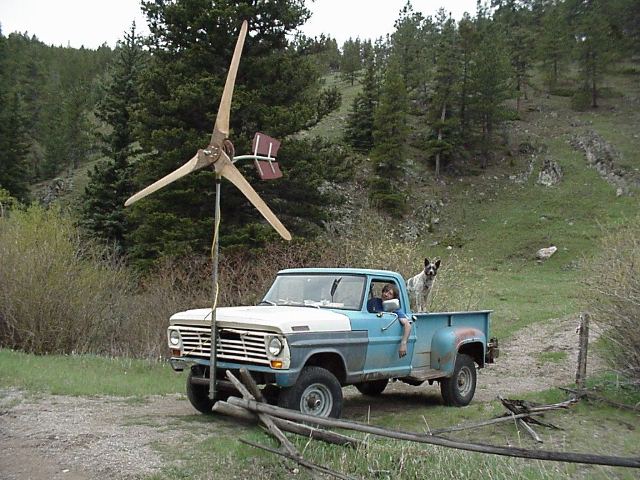
| This page is about an older project of ours. We keep ALL of our projects up on the internet for anyone that's interested...but we are no longer pursuing many of these older ideas. Before starting this project, please check our main Wind Power page to check for similar, more recent designs. These will be the top of the list and flagged with an "active project" tag. If you have any questions about what is current and what is not, or why we no longer work on certain designs, first check out our Wind Turbine Evolution page for a detailed history of how our designs have changed over the years. You can also Email us and we'll fill you in as our email volume permits...check the Evolution page first. |
And, be sure to check out our book Homebrew Wind Power for more small wind power information!
This page is a diary about my latest wind turbine experiment from May of 2003. Although a bit more complex, it features some significant improvements over the brake disk turbines I've made in the past.
Para Español, traducción de Julio Andrade.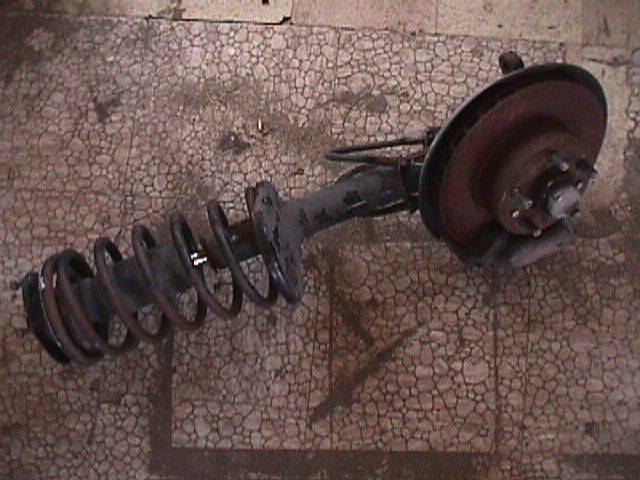
This is what I started with. It's the front strut, brake and wheel assembly from a Volvo 240. The Volvo parts are good, and since they are rear wheel drive this front assembly is simple and inexpensive from junk yards. They also built these cars for about 20 years, so the parts are easy to come by. Volvos are somewhat heavy cars, so the bearings are large and the brake disks are larger in diameter than most.
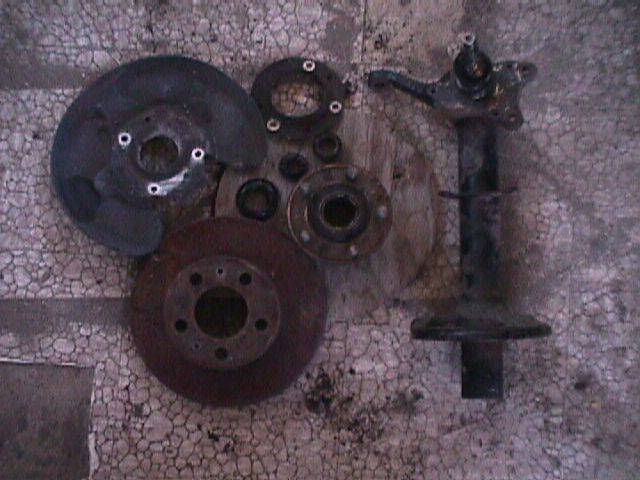
Above are pictured the important parts. The spindle and strut tube will make up the main frame of the wind turbine. The blade will bolt down to the front of the brake disk, where the rim used to fit on the car. That stator shown below will replace the backing plate that used to cover the back of the brake rotor. Of course the machine will use the wheel hub, and the strong wheel bearings from the car. I take some care to inspect the used bearing, clean it and grease it again. Normally in the past I've used the same brake disk that came with the assembly. In this case, I noticed that the front brake rotors from the Volvo 740 (a heavier car) were a whole inch larger in diameter (11 inches), and they fit over the same wheel hub, so I aquired the larger brake disk off the 740 for this project. It's important to consider when disassembling these struts that the spring is under some tension! One should compress and clamp the spring.
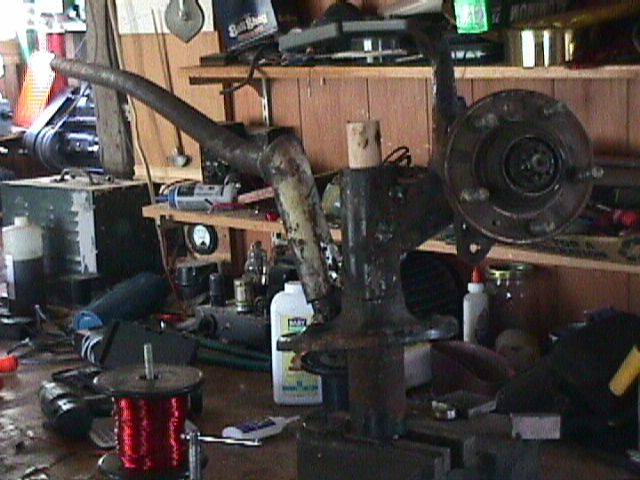
This wind turbine has a furling system so that in high winds the alternator and blades will turn sideways out of the wind and protect itself from overspeeding. To do so, the tail must raise. The weight of the tail ultimately determines when the machine can furl. This seems to be the most popular furling system on small home brew machines, and the idea has been perfected by Hugh Piggott from Scoraig Wind Electric. Go to his site, or www.windstuffnow.com for details about how this system works. In this case, the center of the alternator sits about 4 inches off to the side from the center of the mast. I did this by cutting the strut tube off at about 4 inches from the wheel spindle and welding it onto the side of the remaining tube at somewhat of an angle. The tail will pivot over a 1 inch diameter pipe which is welded to the assembly at an angle of about 20 deg from the mast.
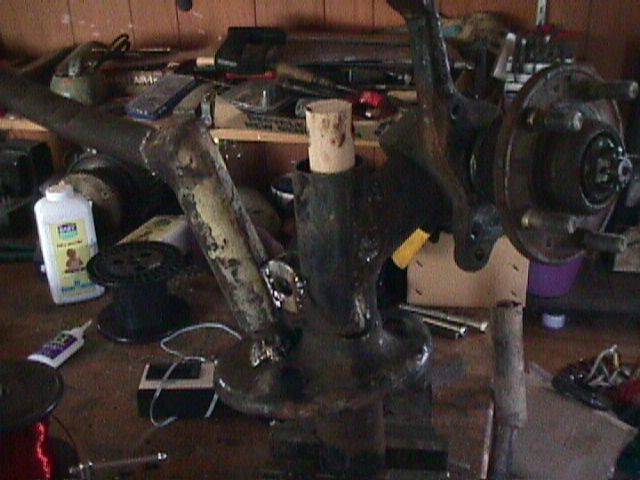
Above is another picture of the same assembly.
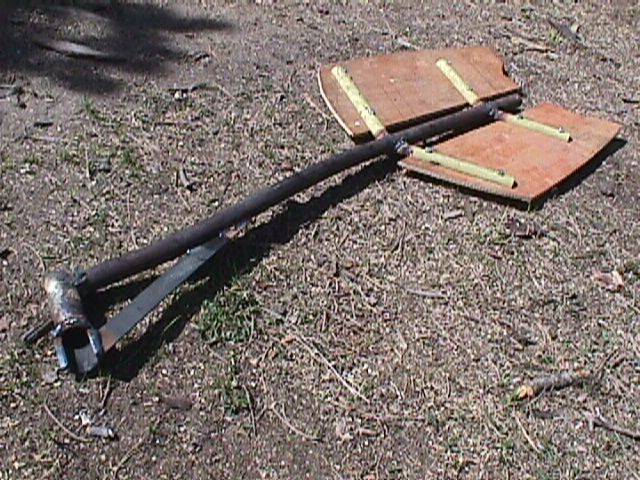
The tail is shown above. Actually - when I got 'round to testing this the tail came up too small and too light weight. I wound up making it slightly larger in the end. The end which attaches to the wind turbine is a short segment of pipe slightly larger than the 1 inch diameter pivot, which is welded to the main frame of the windmill.
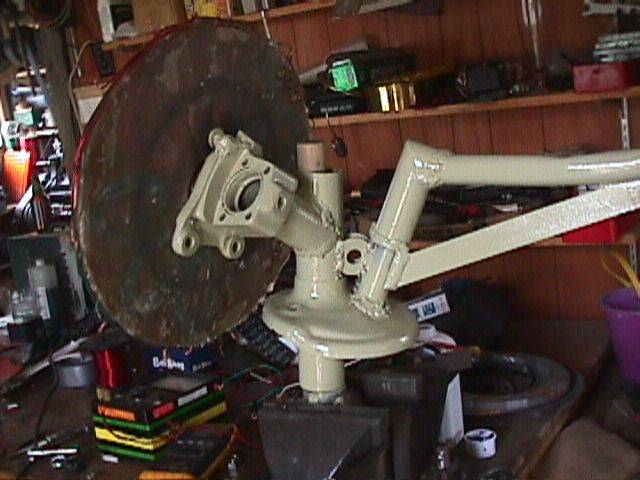
Above is pictured the main frame, with the tail mounted. I painted the metal frame with green epoxy enamel to prevent rust and keep things looking as nice as possible.
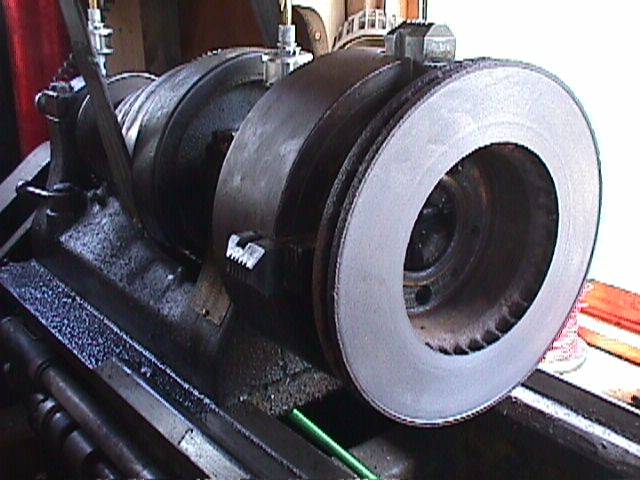
Although probably not necessary, I like to cut a bit off the back of the brake disk from the inner diameter, almost all the way out to the outer edge, but not quite. This leaves an edge, about 1/16 inch high, which catches the magnets to help hold them in. It also leaves a nice clean flat surface. Since the magnets will also be glued and held in with some polyester resin, it's important after cutting this to clean it and make sure it's oil and iron filing free so the resin sticks well.
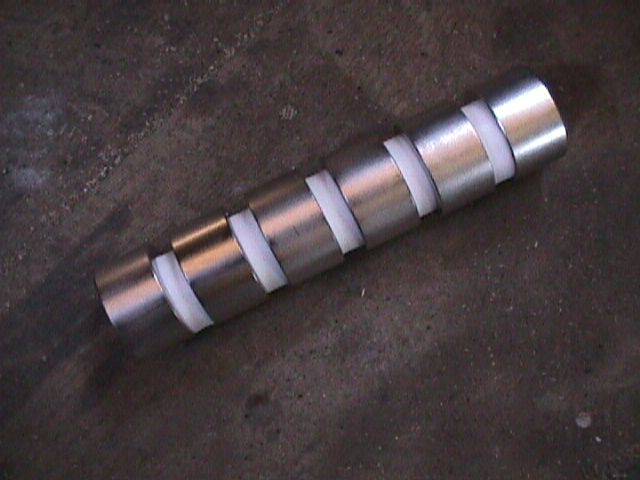
Pictured above are the magnets I used. This machine has 12 magnets, each one is 1.8 inch diameter and 1 inch thick.
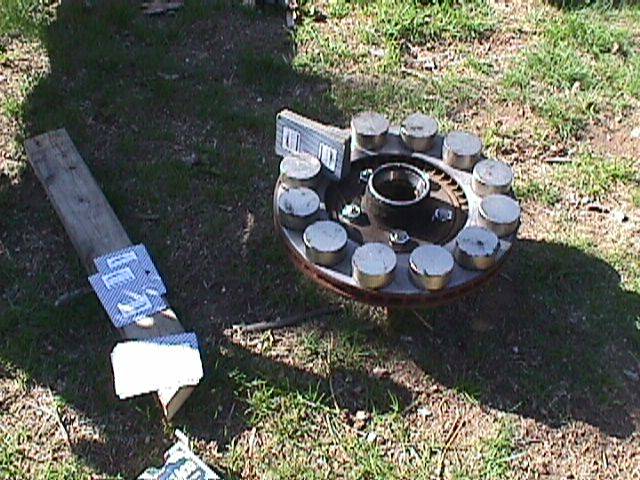
The magnets lay down on the brake disk such that each one has the opposite pole facing up as the one next to it. Alternating North and South poles all around the disk. I push the magnets all the way out to the lip I cut and space them approximately by eye. Then I use shims (playing cards) and go 'round the circle so they are perfectly spaced. The space between the magnets here is about 1/2 inch (or exactly the thickness of 49 playing cards).
I think the leakage (magnetic field which is going from magnet to magnet before it has a chance to go through the coils) between these 1 inch thick magnets is significant. More space between them would reduce that, it is also possible that thinner magnets (like 1/2 inch) might even work as well, or better. One the magnets are spaced evenly, I wrapped some tape (duct tape) around both the inside and outside of the brake rotor so the edge stuck up about half an inch, creating a dam, or cavity in which I could pour polyester resin to glue the magnets down and keep the space between them. I wish I'd caught a picture of that.
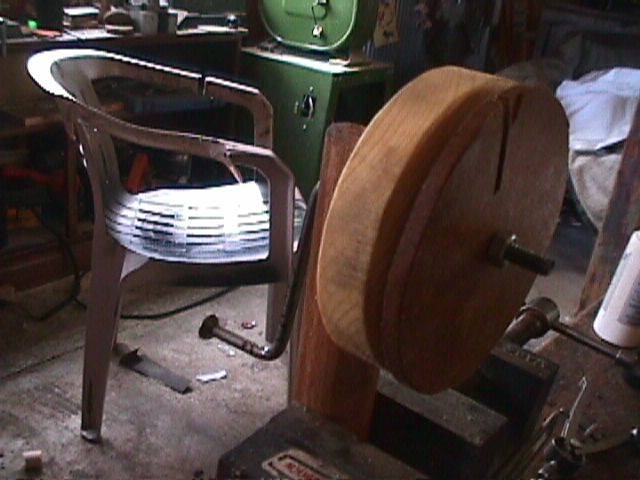
I made a simple hand cranked coil winder.

I tested lots of coil shapes and sizes. Lots of things worked, but through lots of testing and some good advice I wound up deciding on this wedge shaped coil. The coils are wound from AWG 14 wire, and each coil has 60 turns. They are 3/8 inch thick, and the width (I never measured it) is such that exactly 3 coils fit over 4 magnets. Unlike the past machines I made which were single phase, this one is 3 phase. This setup seems to squeeze a bit more power from the same magnet rotor and also offers some benifits in reducing line loss. The alternator will also run more smoothly as 3 phase, meaning basicly less vibration. Since there are 12 magnets, I need 9 of these coils and 3 coils will be wired in series to make up each phase.
The inside of the coil winder is waxed (I used crayons) so that glue wont stick to it. After the coil is wound, and the top removed from the coil winder, I put thin viscosity cyanoacrylate 'super glue' in the coil and spritz it with accellerator which hardens the glue instantly. This makes for very hard, strong coils that don't come apart easily.

Pictured above are the coils, and the magnet rotor (the magnets are not glued down yet, actually I never did that till the very end and never got a picture of it finished).
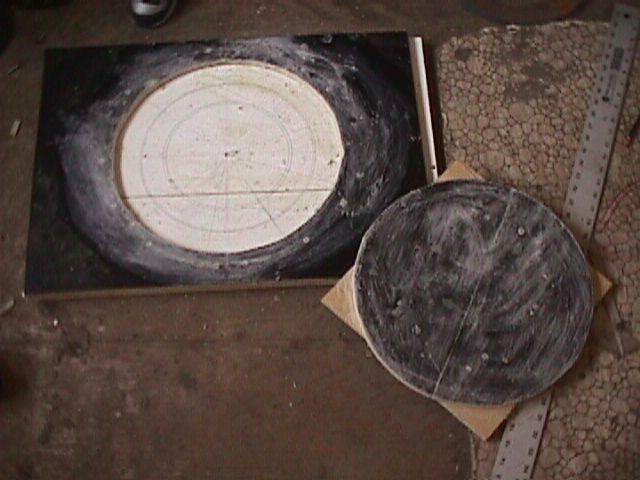
I made a mold out of partical board. The circle is 14 inches in diameter and I divided it into nine parts and drew lines so that I know where to place the coils. The top of the mold is the cutout from the bottom. The mold is 1/2 inch thick. I waxed the mold so that the resin would not stick to it. Once I place the coils and pour the resin, the top will get clamped in, and the wires from each coil will poke out the edge so all the wiring will be done later.
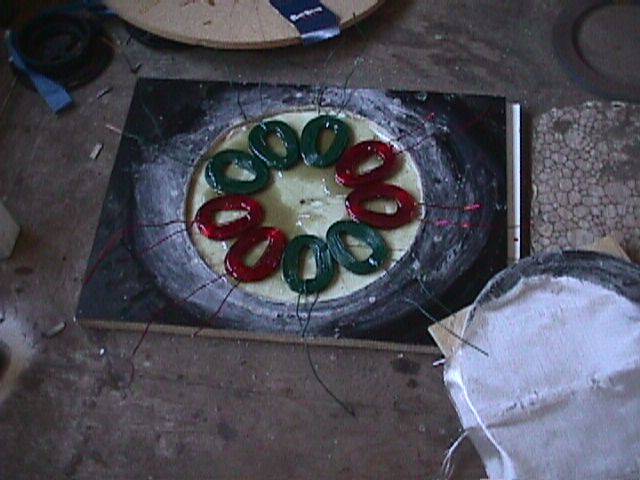
I cut two disks of fiberglass fabric about 14 inches in diameter. I put one down in the bottom of the mold before placing the coils. Then I put down a thin layer of polyester resin. I then put each coil in its place. I took care to make sure each coil is placed the same way. In other words... when the coil comes out of the winder, it has a top, and bottom side. I made sure they are all the same way so that the inside wire of the coil (the start) and the outside wire (the end) come out the same for each coil. Although not absolutely necessary it makes for much easier wiring later on. Once all the coils were placed, I filled up the mold with polyester resin mixed with talcum (baby) powder. The powder makes the resin go further and makes things a bit stronger. Once the mold was filled I put another fiberglass fabric disk over the top, and poured over some straight (no talcom powder) resin. I thin clamped the top on the mold with the wires poking out.
The reason for the red, and green coils is simply that I ran out of magnet wire! The green stuff is extra high temperature wire rated for about 400 deg F, and the red is less - but it will work fine.
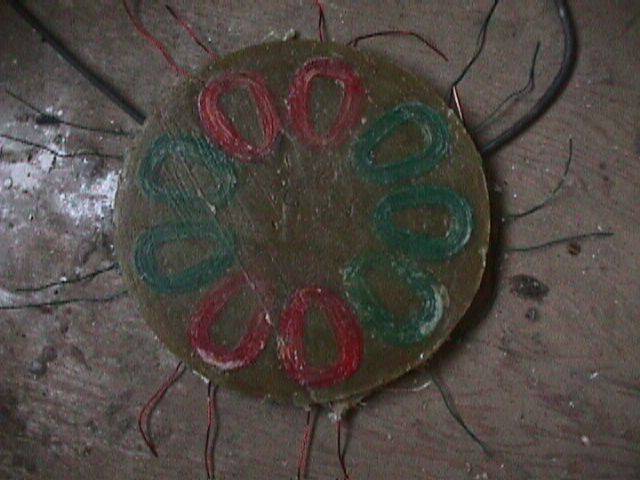
After a couple hours I opened the mold and the stator is pictured above.

You can see in the picture above how the center of the stator is drilled out the same as the backing plate. The center hole has to be a bit larger (2.5 inches) so that the bottom of the wheel hub will fit inside it. The mold could have been modified to leave this hole in the stator and it would've saved some resin, but it was easy to use a hole saw and resin is cheap. On past machines I've made, the back of the stator was plywood, and steel laminates (which help to conduct the magnetic field through the coils) were glued into the plywood. The coils were glued over the top of the laminates, and the plywood bolted to the windturbine frame. A problem I had was that the laminates were getting yanked out of the plywood by the very strong magnets. In this machine, the laminates will be a seperate part which simply lay (stuck there by the force of magnets alone) behind the stator. Or, with a smaller and faster prop it would probably run just fine without laminates at all.
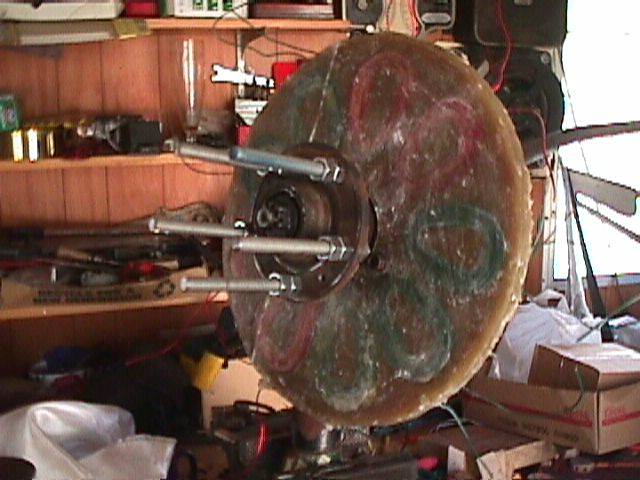
Pictured above is the stator bolted onto the machine. I've also got the wheel hub on here. You can see how the studs (where the lugnuts used to go) have been replaced by longer (7 inch long) pieces of 1/2 inch allthread. The studs were pressed in, and are easily knocked out with a hammer. The allthread is held on with nuts on each side, and then another nut is used on each one to hold the magnet rotor out the proper distance so that the magnets run very near (about 1/8 inch) the stator.
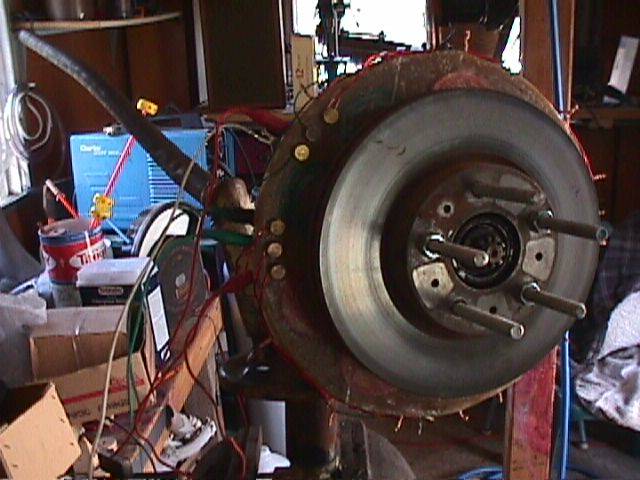
Above the whole machine starts coming together so that I can wire, and test the alternator. I used 6 brass bolts for binding posts to hook up the 3 phases. My intention with this alternator was to wire it in Delta.
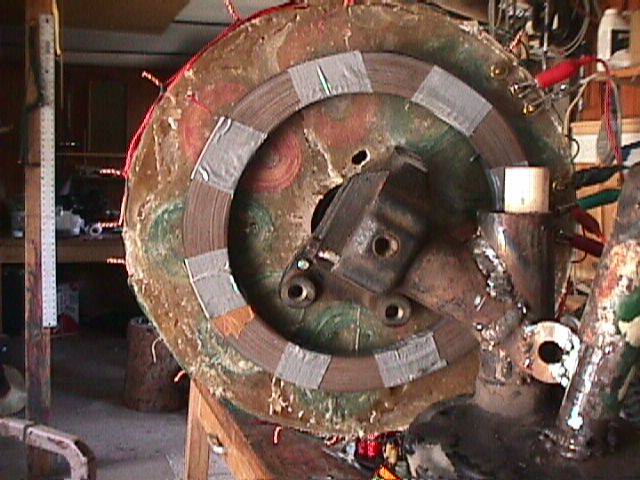
Here you can see how the laminates simply "stick" to the stator when the magnetic rotor is on. This is convenient, because it is easy to remove the laminates before removing the magnet rotor! It can otherwise be difficult to pull the magnet rotor loose when the laminates are built into the stator. Of course, this design with the fairly thick coils and removable laminates means I have a pretty thick airgap (distance from magnets to laminates). Past machines I've made could have much thinner coils and probably make slightly better use of the magnets.
The laminates I used here are actually a coil of very nice Silicon steel which I got from Ed at Windstuffnow.com. Also go there for lots of good information on all aspects of building and designing small wind turbines.
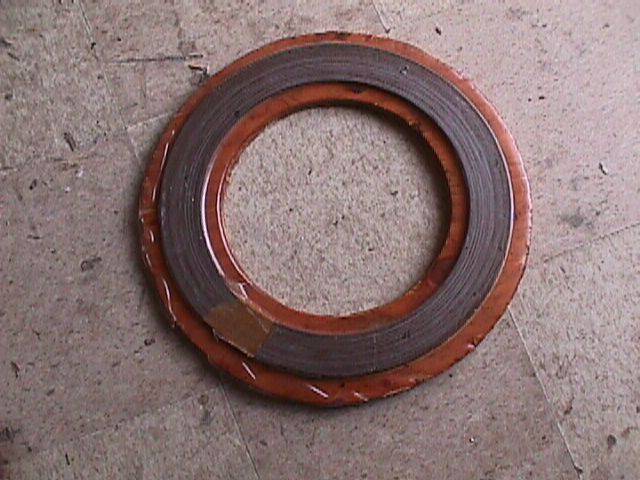
Probably not necessary, but I glued the steel laminates into a plywood ring to make them easier to handle and prevent corrosion.
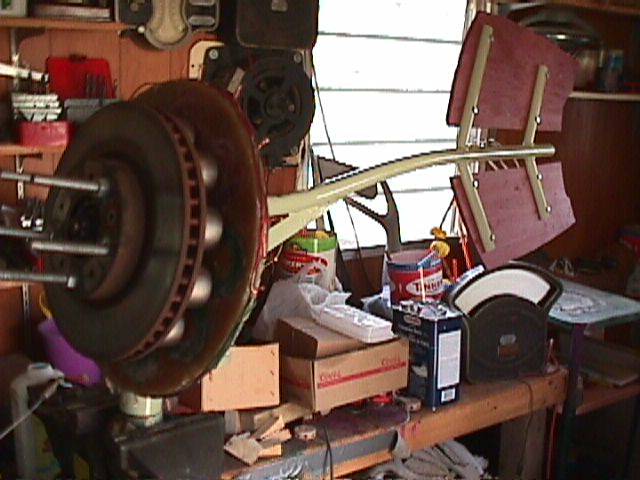
Here the machine is pretty finished up except for the prop. At this point I've got about 20 hours into the project if I don't count the mess I have to clean up later.
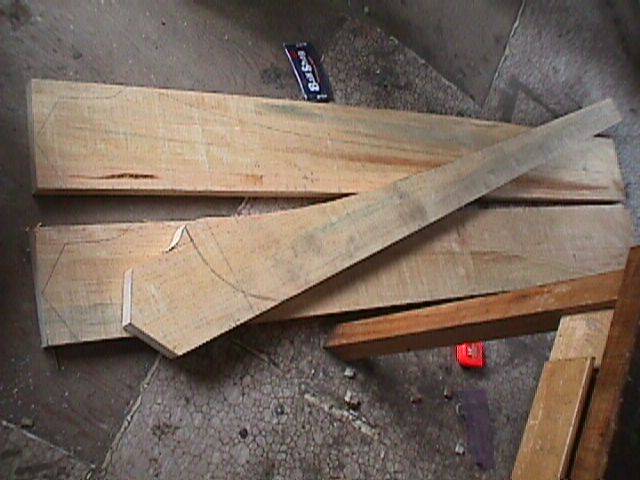
I made the blades from wood about 8 inches wide and 1.5 inches thick. Each blade started out 5 feet long, for a 10 foot prop. Here you can see I cut out the shape for one prop. Then I used it as a template and cut the others to match.
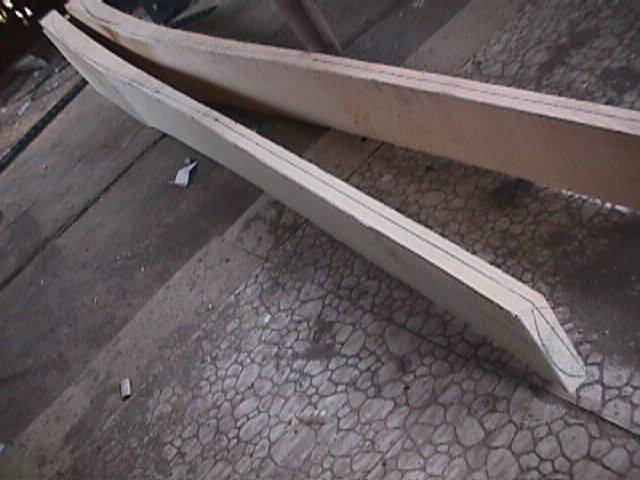
These are simple blades (as usual with me...). The tips are pitched about 4 deg, and the middle of the blade about 6 deg. From there it pitches steeper and steeper until the angle takes up the board thickness near the root of the prop. The airfoil is designed to do little more than 'look like an airfoil' and the thickest part of the airfoil is about 1/3 of the way back from the leading edge towards the trailing edge.
It'd probably work better if I designed it 'properly'. Hugh Piggot has some good information on this on his website here and Ed from windstuffnow.com offers some nifty software which figures it all out for you!
I've seen several commercial machines which have very simple non-tapered, non twisted (straight pitch) blades which work fine, so it inspires to me to keep things simple.
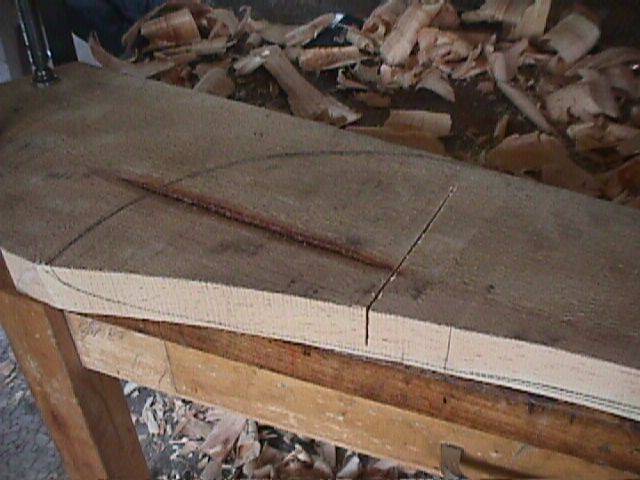
Before doing any carving, I cut one slot with a cross cut saw at the point where the angle of the blade is steepest. This is insurance that I won't ruin the hub area of the blade with the drawknife should I make a mistake or have the wood split.

After attending Hugh's seminar this spring... the drawknife has moved to the top of my list as the favorite tool to use. Very fast, and very accurate. No need for a chisel and the only power tools were used for finishing. I roughed out the whole prop with this quickly and then finished it up with a power planer and a belt sander.
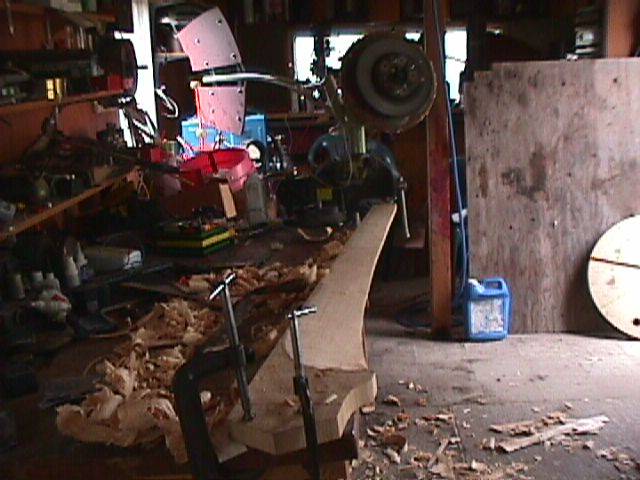
Pictured above the top of one blade is finished.
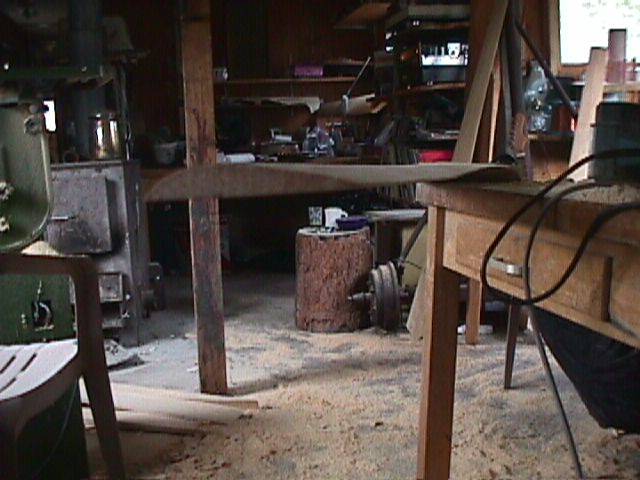
Here you can see the airfoil, and the back of the prop.

I rounded the tips to look nice, although later in testing I wound up cutting them off as the prop was too large and a bit slow.
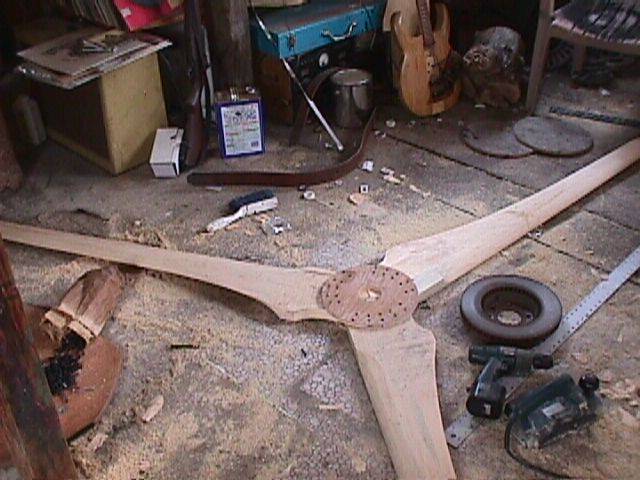
The blades are sandwiched between two plywood disks and held together with a ton of screws. In the past I've used glue here, but I opted not to this time thinking that the screws, along with the tight squeezing that happens when the prop is bolted on would be good enough. This way if I ever need to replace one blade it will be easy.
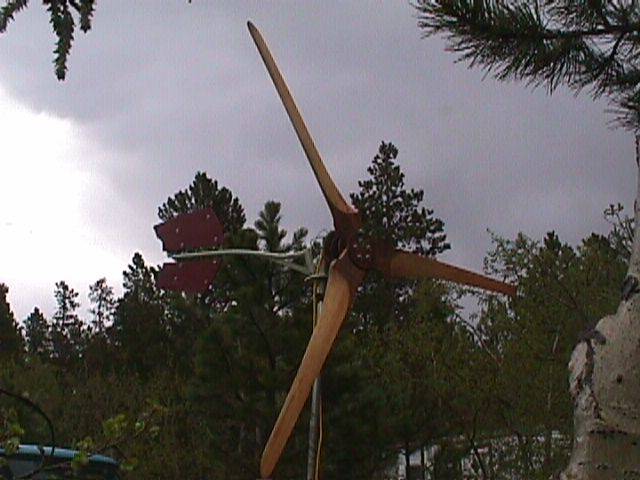
Pictured above she's pretty much finished up on the nose of my truck for testing. When I do this I have a battery in the truck on the floor, some rectifiers, and meters so I can get a rough idea of how much it charges at certain speeds. This also allowed me to test the furling setup. In the first test it was clear the tail wasn't quite big enough or heavy, as it wouldnt run square with the wind and started furling at about 15 mph. The next morning I increased the tail size some and made it from thicker wood. As it is now - the tail is back about 36 inches from the machine, and its about 4 square feet in area. It works reasonably well, although a bit larger might be better. I'm keeping it as it is because my tower is not so strong and I want it to furl early.
This is a big improvement from past machines, mainly in that it turns in practically no wind at all and the slightest breeze spins it up to charging speed quickly and quietly. Past machines I've made wouldn't start till they saw a 10mph wind, and then it took them some time to spin up--so they were not nearly as responsive. The reasons for this improvement: the good laminate material I got from Ed, the 3 bladed prop, and the poor (wide) airgap (these laminates are not seeing near the magnetic field intensity as others I've made). It's always spinning even on a still day - and it seems to be making an amp or two at 7mph. At 10 mph it charges 12 volts at 8-10 amps. 15 mph I see about 15, and at 20 mph it's doing 30 amps and just starting to furl. At 25 mph it's furled out of the wind almost half way and doing about 35 amps and at 30 mph its more than half way turned out of the wind and charging about 45 amps. I believe the power I'll get from this in very light winds will add up significantly and prove it to be a much better producer than others I've made, some off which actually had more powerful alternators.
In one test I added some weight to the tail. Although it was still somewhat turned out of the wind, it was producing about 60 amps at 30mph. So, if I add weight to the tail it will produce much more, but as it is it's less stress on my tower. I also think that the majority of the power I see from it will be in winds below 20mph so this is the area I'm concerned about.

Above is a good picture of how we test them on the truck. Click Here to see a brief movie of the truck test!

In this picture I'm tying it up so we can more easily navigate the trees on our driveway for the ride home. This picture does give a good idea of how the furling system works, as the wind puts force back on the blades it makes the machine want to fold up like this - but in order to do so the tail must be raised! So the furling system is a balancing act between the force back on the blades, and the weight of the tail.
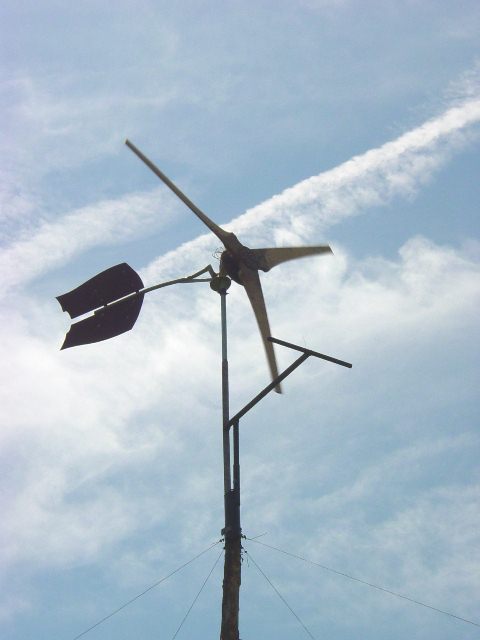
This is how it looks now up on my tower with the blades cut down to 9 foot diameter and the larger tail. It's been doing well now for a few days, starting to turn below 5mph and definitely making power. It's definitely an improvement over past machines. I notice significantly less line loss due to the 3 phase power, and it generates in much lower windspeed because it turns much easier. To do it over again, changes I'd make would be a still larger tail, and/or... cut down the prop size maybe a bit more. I'm pleased with it though and will probably leave it as is. Can't wait to make the next one!
